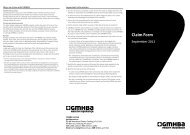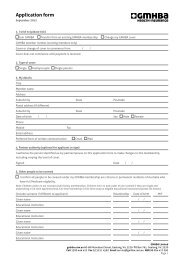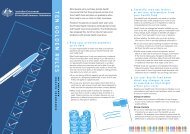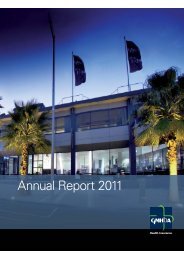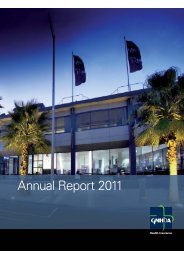GMHBA AnnuAL RepoRt 2010 - GMHBA Health Insurance
GMHBA AnnuAL RepoRt 2010 - GMHBA Health Insurance
GMHBA AnnuAL RepoRt 2010 - GMHBA Health Insurance
You also want an ePaper? Increase the reach of your titles
YUMPU automatically turns print PDFs into web optimized ePapers that Google loves.
<strong>GMHBA</strong> Limited ABN 98 004 417 092<br />
<strong>GMHBA</strong> Limited ABN 98 004 417 092<br />
Notes to the Financial Statements for the year ended 30 June <strong>2010</strong> (continued)<br />
16. Auditor’s remuneration<br />
47<br />
<strong>2010</strong><br />
$’000<br />
2009<br />
$’000<br />
Audit and review of financial reports 110 100<br />
17. Market Risk<br />
Market risk is the risk that the fair value or future cash flows of a financial instrument will fluctuate<br />
because of changes in market factors. Market risk comprises three types of risk: currency risk (due<br />
to fluctuations in foreign exchange rates), interest rate risk (due to fluctuations in market interest<br />
rates) and price risk (due to fluctuations in market prices). The following policies and procedures<br />
are in place to mitigate the company’s exposure to market risk.<br />
• A risk management plan and investment plan setting out the assessment and determination<br />
of what constitutes market risk for the company.<br />
• The Investment Committee is responsible for compliance with the investment plan which it<br />
monitors for any exposures or breaches. It is also the role of the Investment Committee to<br />
determine action plans in mitigation of market risk.<br />
Currency risk<br />
Currency risk is the risk that the fair value of future cash flows of a financial instrument will<br />
fluctuate because of changes in foreign exchange rates.<br />
The company does not have any foreign investments and therefore is not exposed to foreign<br />
exchange rate risk.<br />
Interest rate risk<br />
Interest rate risk is the risk that the value of future cash flows of a financial instrument will fluctuate<br />
because of changes in market interest rate. The company invests primarily in financial instruments<br />
with fixed interest rates which expose the company to fair value interest rate risk.<br />
The following table illustrates the sensitivity of the net result for the year ended 30 June <strong>2010</strong> to a<br />
reasonably possible change in interest rates of + / -1% (2009: + / - 1%). These changes are<br />
considered to be reasonably possible based on observation of current market conditions. The<br />
calculations are based on the company’s financial instruments held at balance sheet date, with all<br />
other variables held constant.<br />
<strong>2010</strong><br />
2009<br />
$’000<br />
$’000<br />
+1% -1% +1% -1%<br />
Money Market Securities<br />
Net result (603) 612 (650) 661<br />
The company actively manages its investments in high quality liquid fixed interest securities and<br />
cash for the duration of the fixed interest period, which should be taken into consideration when<br />
considering the impact of the above movement.<br />
47







